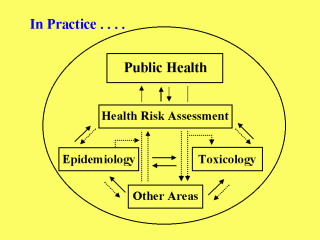|
|
|
|
front |1 |2 |3 |4 |5 |6 |7 |8 |9 |10 |11 |12 |13 |14 |15 |16 |17 |18 |19 |20 |21 |22 |23 |24 |review |
 |
From the foregoing discussion, it is clear that the interrelationships among the various public health disciplines or fields are
multidirectional at the least. It is important to realize here that just because there is some indication showing a marriage between two disciplines, such as toxicology and risk assessment or risk assessment and public health, this information alone is not necessarily enough to identify the actual proposer of such a wedlock. It was the understanding of the basic neurotoxicity of (methyl)mercury, even from just animal models alone, that had likely facilitated the epidemiologic investigation of the Minimata incident that took place in Japan in the 1950s. However, without some epidemiologic form of human exposure assessment, the victims of the Minimata disease might never have been diagnosed as suffering from organomercurial poisoning (through the ingestion of the contaminated seafood). Also, the investigation of this epidemic might not have been successful or made possible, if it were not for our knowledge in ecotoxicology, biostatistics, or more importantly for the many years of active research sponsored by the Japanese government. This experience and many others suggest that the above flowchart is rather too simplistic to describe the actual interrelationships between epidemiology and toxicology, and their interrelationships with other disciplines. The basic rule still seems to apply, however, that in an underdeveloped country where public health is not considered much a national agenda, toxicology and epidemiology are unlikely to merge any time soon as a field of academic pursuit. |